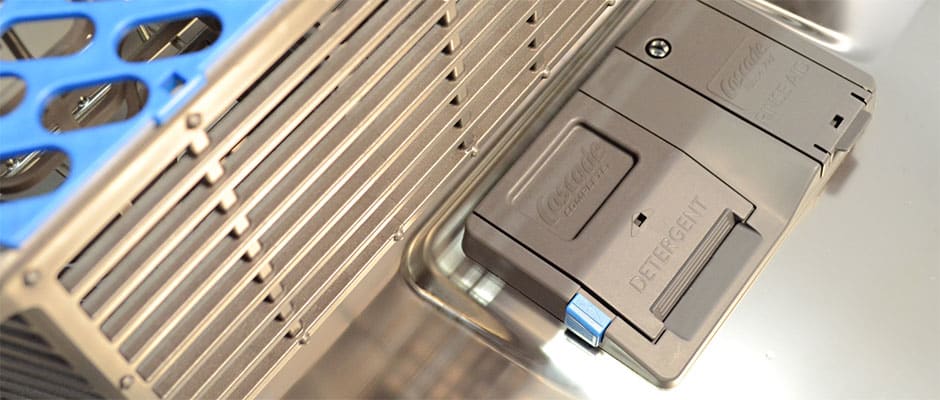Pros
Cons
Introduction
The second thing you'll notice is the Energy Smart button. If you live in one of the few places in the US where smart electric meters have been deployed, this GE can look at your electric rates and decide when it's cheapest to run a wash. That makes it one of the first smart grid capable appliances on the market. Although the GDT550HSDSS overflows with extra options, its performance is middling.
Design & Usability
{{section_header}}{{ section.name }}{{/section_header}}
If looks could kill...
The GDT550HSDSS looks super serious. The stainless steel door gives it the impression of a heavy-hitter, especially when there’s steam coming out of its air vent in the corner. The top-mounted control panel has a total of seven buttons and 14 indicator lights. Simplicity and modesty have clearly been forsaken here: this machine’s design is all about intimidation.
When you open that door, you’re going to be greeted by a pair of full-size cutlery baskets staring you in the face. Hanging off the front of both racks, they look like the grille of an 18-wheeler, barreling down the interstate with a rush delivery of cold, watery justice. Those baskets make the racks feel cramped, but we still found that the GDT550HSDSS can fit ten place settings and a serving setting just fine.
Jumping back outside again, the intimidating control panel is actually very simple to use. Intuitively designed, you basically start from the left, first by choosing your wash cycle, then moving along to the right while picking the additional wash options, such as the steam pre-wash and wash temperature boost. Audible beeps and indicator lights confirm your choices while guiding you along. The very last button you reach on the right side is the Start button. After that, you just shut the door, and the bruising commences. Sitting dead center at the top of the door is an LED. When that light turns orange, you know that IT. IS. ON. When the GDT550HSDSS is done taking names, that light turns green and a short, pleasant jingle plays.
{{photo_gallery "Design Gallery"}}
Features
{{section_header}}{{ section.name }}{{/section_header}}
Choices, choices...
The GDT550HSDSS is one of the few appliances already on the market that's compatible with smart grid technology, which can charge different rates depending on time of day. "Smart" electric meters can also communicate with appliances to let the user know how much it'll cost to run them.
The GE's Energy Smart cycle takes those varying rates (known as "dynamic pricing") into account. It will wait until energy costs are lowest to run a cycle, likely running in the middle of the night when energy demand—and the dynamic price of electricity—falls.
When it's not deciding when your dishes should be done, the GDT550HSDSS makes up for it by allowing you to micromanage your dishes. Want dry dishes when you’re done? Turn on the Heat Dry. Need to break out the big guns for tough, baked-on stains? Wash temperature boost and sanitize options will have you covered. Only have half a load? Change the Wash Zones to spray only the top or bottom rack to save water, time, and electricity. You can even put on your goggles and your most fancy hat and activate the Steam pre-wash option in lieu of soaking your dishes beforehand. Then call yourself a steampunk. You deserve it.
There are four cycle choices to choose from: Light, Normal, Heavy, and AutoSense. The first three are pretty self-explanatory, designed for varying levels of soil. If you're undecided, you can always leave it up to the AutoSense cycle, which uses the GDT550HSDSS’s soil sensors to determine how big a helping of vengeance needs to be served. There is no official “Quick Wash” cycle, but the Normal finishes in about 86 minutes, and is the GDT550HSDSS’s fastest cycle.
Performance
{{section_header}}{{ section.name }}{{/section_header}}
All bark, no bite.
So how did this brawny, versatile dispenser of soapy beatings do on our tests? Sadly, not that well. The GDT550HSDSS was run through our stain tests using its default settings. This allows us to make accurate scientific comparisons between machines. Stripped of its arsenal, the GDT550HSDSS proved to be mediocre in hand-to-hand brawls.
The Normal cycle, while able to remove most of the meat, egg, and milk stains, had a lot of trouble with baked-on spinach and oatmeal, which are the two toughest food stains at this level. On the bright side, there were only trace amounts of redeposit, indicating at least that particles that have been washed off were being properly drained away. The Normal cycle clocked in at a brisk 86 minutes.
The Heavy cycle performed a bit better with the spinach and oatmeal, but had problems with the burnt cheese and burnt sugar. Once again, there were only trace amounts of redeposit, and the cycle finished in 144 minutes.
Our conclusion is that the GDT550HSDSS on its default settings is less effective than some of its competitors. But it does give you fast cycle times, plus lower water and energy consumption, and an estimated annual running cost of just $27.42.
Conclusion
{{section_header}}{{ section.name }}{{/section_header}}
With great power comes... a user's manual.
In summary, the GDT550HSDSS does some things well, but dish cleaning isn't at the top of the list. We found that this machine had quick cycle times and is inexpensive to operate, but could only manage mediocre scores on our stain tests. But if you're looking for a machine that's smart grid compatible, this GE is one of your only choices.
Introduction
{{section_header}}{{ section.name }}{{/section_header}}
The GE GDT550HSDSS looks beastly with its fancy digital display and indicator lights. However, it takes more than fancy controls or a double helping of cutlery holders to intimidate the power of science. The numbers show that the GDT550HSDSS is only a mediocre performer when none of its extra options are engaged. While it does kind of feel like we're asking it to challenge a bear to single, unarmed combat when there's a perfectly good elephant gun nearby, our testing standards call for results based on default settings on all the machines we test, in order to keep the playing field as level as possible. Besides, everyone knows bears are bulletproof, and angry.
Performance
{{section_header}}{{ section.name }}{{/section_header}}
Mediocre without any of its extra features engaged.
The GDT550HSDSS’s performance scores on its Normal cycle reminded us of the Quick Wash cycles on other dishwashers. It could tackle the lighter meat, tea, milk and egg stains, but had problems with the baked-on oatmeal and spinach stains. It took a little longer than a real Quick cycle, clocking in at 86 minutes, but that’s a very good time for a Normal run.
The Heavy cycle does a better job with the stains that gave the Normal cycle problems, but wasn’t so good at the additional stains we throw in for Heavy tests: burnt sugar, burnt cheese, and baked-on lasagna. Large, visible chunks of cheese were left behind, and a small portion of the washed-off lasagna was left sitting in a nasty puddle inside its casserole. This cycle took 144 minutes.
Given the relatively quick cycle times at default settings, engaging the GDT550HSDSS’s extra wash options to tackle the tougher food stains does not seem unreasonable. It’s like the dishwasher was designed that way, in order to allow the user control over how powerful a wash they want to use, and consequently, how much water and electricity will be consumed.
{{photo_gallery "Performance Gallery"}}
Efficiency
{{section_header}}{{ section.name }}{{/section_header}}
A minimal drain on your resources, including time.
At default settings, the GDT550HSDSS has very good efficiency scores. Normal cycles only use 4.07 gallons of hot water and 0.54 kWh of electricity, adding up to an estimated cost of just 11 cents per run. Heavy cycles use 7.53 gallons and 0.82 kWh, adding up to 19 cents each run. We estimate the annual cost of running this machine to be $27.42, which is on the low end. For comparison, the average annual cost of the machines we’ve tested is around $32. The GDT550HSDSS has a minimal impact on your water, electricity, and time, and even has a few options to reduce your consumption even further.
{{photo_gallery "Efficiency Gallery"}}
Capacity
{{section_header}}{{ section.name }}{{/section_header}}
More space for silverware than you'll ever need.
The GDT550HSDSS has two monstrous, full-size cutlery holders. They are easily the first things you will notice when you open the door. That means some space in the racks was sacrificed, though, which made for a tight fit. Nevertheless, we were able to fit ten place settings and a serving setting inside this dishwasher. There wasn’t much room afterwards for extra dishes or cups, but definitely plenty more spaces in the cutlery baskets left over for silverware beyond just the ten place settings.
{{photo_gallery "Capacity Gallery"}}
Meet the tester
Checking our work.
Our team is here to help you buy the best stuff and love what you own. Our writers, editors, and experts obsess over the products we cover to make sure you're confident and satisfied. Have a different opinion about something we recommend? Email us and we'll compare notes.
Shoot us an email

